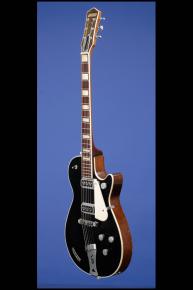One of the Very First Duo Jets
(ca. August, 1953)
This late Summer 1953 Duo Jet with a 13 1/4-inch-wide, 2 inch deep guitar weighs just 7.80 lbs, has a fat nut width of just over 1 11/16 inches, a wonderful medium-to-thick neck profile and a scale length of 24 1/2 inches. Chambered mahogany body, triple-bound pressed arched top with black plastic laminate, mahogany neck, and white-bound Brazilian rosewood fretboard with 22 original 'small' frets and inlaid pearloid block position markers. Single-bound, dark brown maple faced headstock with inlaid pearl Gretsch "T-roof" logo. Individual open-back Grover StaTite tuners with oval metal buttons and hexagonal bushings. Two single-coil DeArmond pickups with outputs of 3.13k and 3.05k. Four-layer (white/black/white/black) plastic pickguard. Four controls (three volume, one tone) and one three-way selector switch. The potentiometers are dated "134 304" (Centralab, January, 1953). Earliest style plain-top chrome plated brass control knobs with cross-hatch pattern on sides. Earliest style Melita Synchro-Sonic bridge which is 'anchored' directly into the top, and chrome cut-out "G-hole flat" tailpiece. Original two-layer white on black plastic neck heel cover. This is one of the very first Duo Jets, with a silver cut-out Gretsch 'Drum' logo on the bass side of the tailpiece, the Melita bridge anchored directly into the body, a four-ply 'white' pickguard and, as with the very early Gibson Les Paul's, no printed Gretsch identification label in the control cavity. Usually the serial number is etched roughly onto the back of the large control cavity cover. On this very early guitar there is an 'X" etched onto the underside of all three control covers and a pencil "X" on the underside of the top (visible inside the large control cavity). This very rare guitar is in exceptionally fine and totally original (9.00+) condition. There is some minor belt buckle wear on the back of the body, some edge wear to the lower edge, and the face of the headstock has a small (cosmetic only) crack across part of the dark brown maple veneer, otherwise this is as fine an example as one could ever wish to find. Housed in the original Gretsch four-latch straw-colored hardshell case with burgundy velvet lining and Gretsch silk banner (8.75).
"In early 1954 [actually August 1953], Gretsch premiered its single cutaway Jet series, a line of quasi-solid-bodies that persisted in one form or another until the end of the Baldwin era. Intended to imitate and compete with Gibson's Les Paul "goldtop" Standard Model, the Jet guitars differed, in a structural sense, in that they were not true solidbodies but semi-solids with top, back and sides formed from separate pieces. Their arched tops were laminated from several plies of pine, maple, mahogany, spruce or sheets of Nitron plastic drum material. The 1954 models issued were the Gretsch Electromatic solidbody Model 6128; Duo Jet in black; 6129 Silver Jet with silver sparkle top; Model 6130 Western-outfitted Round Up; similarly appointed Model 6121 Chet Atkins Solidbody, companion to the Model 6120 Chet Atkins Hollowbody, and, apparently hearkening back to the Gretsch-Bacon banjo days, Model 6126 Duo Jet Baritone Uke and Model 6127 Duo Jet tenor guitar. 1954's 6128 Duo Jet and Model 6129 Silver Jet were fraternal twins. The ebony-topped Duo Jet is finished in natural-mahogany back, sides and neck… [the] earliest pickguards for 1954 are white plastic without "Gretsch" inscribed on it. The pickguard is not cut to fit around the pickups and instead butts against the treble end of the DeArmonds' surrounds. (Jay Scott. The Guitars of the Fred Gretsch Company, pp. 91-92).
"In 1953 Gretsch launched its first solidbody, the single-cutaway Duo Jet. In fact, the guitar was a semi-solid with routed channels and pockets inside, but the visual effect was certainly of a solidbody instrument. In its early years the new Duo Jet had, unusually, a body front covered in a black plastic material, as used on some Gretsch drums. It also had Gretsch's unique two-piece strap buttons (an early take on the idea of locking strap buttons) and the Melita Synchro-Sonic Bridge" (Tony Bacon, Electric Guitars: The Illustrated Encyclopedia, pp. 163-165).
George Harrison bought a 1957 Gretsch Duo Jet early in 1961. "Harrison used the Duo Jet throughout the group's rise to fame, only retiring it when he acquired a double-cutaway Gretsch Country Gentleman in summer 1963" (Tony Bacon, Electric Guitars: The Illustrated Encyclopedia, p. 164).
Translate:











